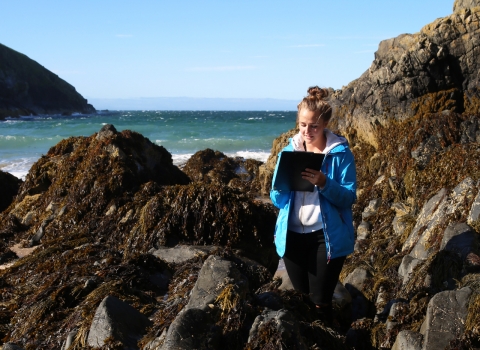Help us learn more about invasive non-native species
Invasive Non-Native Species (INNS) are any living organisms that have been transported outside of their natural range, by human activities or naturally. The spread of INNS can outgrow, kill, or out-compete our local species which can impact food chains and biodiversity. They can damage our environment, the economy, our health and the way we live.
Why monitor the impacts of invasive non-native species?
INNS pose an increasing threat to the biological diversity (commonly known as biodiversity) of our seas.
Having biological diversity is fundamental to the healthy functioning of an ecosystem. The various ecosystems around the Island provide various ‘ecosystem services’ which we humans depend on for our survival. Some examples of ecosystem services include:
• Producing oxygen for us to breath
• Plants and animals as a food source
• Recreational activities
• Education
How do they impact us?
The loss of species can have a number of negative impacts both on the environment and on humans.
For example, invasive non-native species may predate our native species or out compete native species for food and shelter; they may carry diseases; or they may modify the habitat. All of these impacts could lead to the complete change of an ecosystem or the removal of some or all of our native species. This can have devastating impacts on the environment and, as a result, the economy.
The Great Britain Non-Native Species Secretariat estimates that the impacts of invasive non-native species cost £1.7 billion per year in Great Britain alone. These costs are estimated to be even larger when you include the indirect costs, such as the loss of certain ecosystem services. These effects are also likely to be more devastating to islands due to their vulnerability. These impacts are long lasting and compounding unless action is taken to eradicate and prevent the spread of invasive non-native species.
How do they find their way here?
In many instances the introduction of invasive non-native species has been accidental and unintentional.
One major pathway of introduction has been through ballast water, held in a ship's hull to keep it balanced on international journeys. When a ship isn't carrying any cargo, its tanks are filled with water from the local environment (Port A) then, before reaching its destination (Port B), the water - and potentially, invasive non-native species in it - is released to increase buoyancy.
Organisms can also be introduced when they attach themselves to the hull of commercial ships and recreational boats (also known as ‘hull fouling’); through the introduction of species and diseases through aquaculture (i.e. fish farms); introduction via live food and also through anthropogenic or natural flotsam.
Prevention
The Convention on Biological Diversity (CBD) proposes a three step method to prevent the harmful impacts of invasive non-native species. These steps include:
• Prevention
• Detection/surveillance and rapid response
• Control and eradication
The Isle of Man Government is taking steps, through a marine biosecurity plan, to make sure that good practices are in place to reduce the risk of introduction and spread of invasive non-native species in Manx territorial waters, similar to the CBD approach.
Help stop the spread
Help stop the spread of invasive plants and animals in our waters.
Invasive plants and animals from all over the world have been introduced accidentally. Many species have already been introduced into Manx waters and we don’t want these numbers to increase.
They can cause serious environmental problems that can be irreversible and can interfere with the activities you enjoy by clogging propellers, damaging boats, blocking up waterways and increasing the risk of flooding.
They can be small, making them hard to spot, so are easily spread on damp equipment and clothing. You can all help to protect the environment and the activities you enjoy by keeping your kit free from invasive plants and animals. For more information please check out these leaflets
Ramsey Harbour Invasive Species Survey Reports
Can you help MWT?
Little is known about the impacts of invasive species on our shores. This is why Manx Wildlife Trust is keen to collect sighting information which will enable us, and the government, to better understand these species, where they can be found and what their possible impacts could be. We need people to help by reporting sightings of invasive species.
- Read our guide - This includes twenty invasive species, including shrimps, limpets, mussels, crabs, seaweeds, clams and barnacles to help you work out what to look for
- Email your records over to us
What will happen to the information I supply?
MWT will collate all the reports submitted and use them to help us better understand these species, where they can be found around the island and what their possible impacts could be. We will share the findings with the Isle of Man Government.
More information
- More detailed information is available here
- Look out for news on Isle of Man Marine Biosecurity Plan on the Isle of Man Government’s website
- Visit the website of the Great Britain non-native species secretariat
- Marine Invasive Species ID Guide




